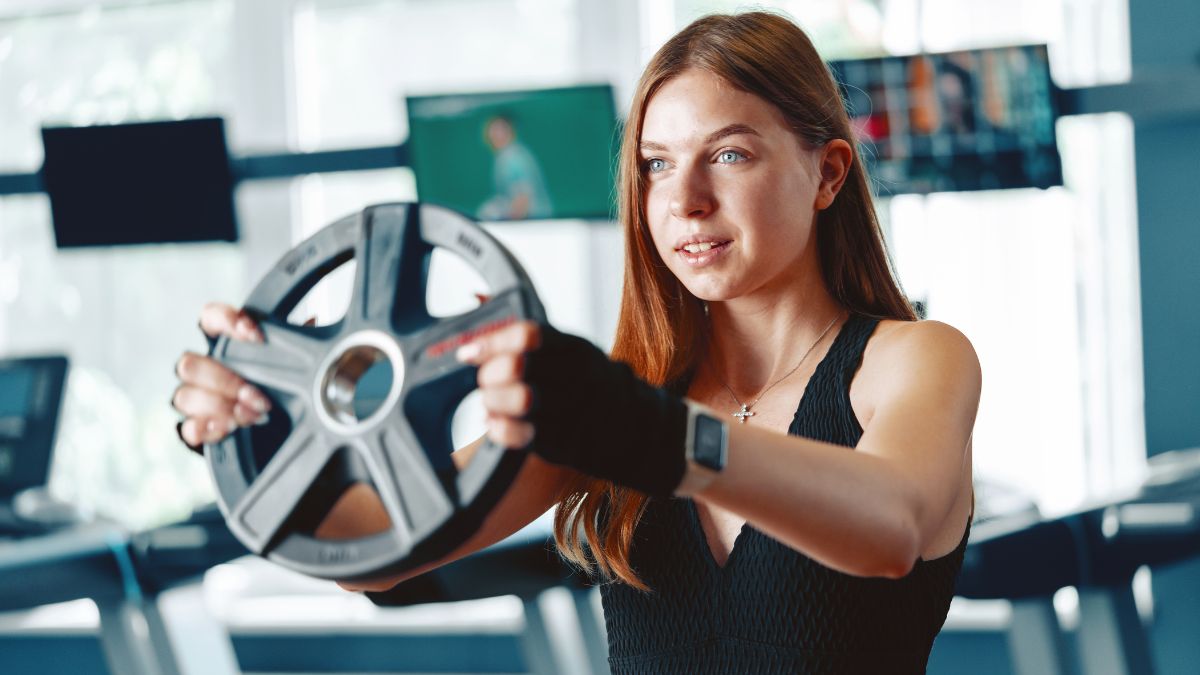Wellness
Beginner’s Guide to Fitness: Easy Steps to Get Moving

Beginner’s Guide to Fitness: Easy Steps to Get Moving
Starting a fitness journey can feel like a daunting task, especially when you’re juggling the stress that comes with being a young adult. With gen z stress statistics on the rise, it’s more important than ever to find ways to move your body and clear your mind. Lucky for you, getting started with fitness doesn’t have to be complicated or intimidating. In this beginner’s guide, we’ll break down easy steps to help you get moving, whether it’s a brisk walk in your neighborhood or trying out a simple workout routine at home. So lace up those sneakers and let’s dive into a healthier, more active lifestyle together.
Understanding Fitness Basics
Importance of Physical Activity
Engaging in physical activity is crucial for everyone, especially young adults. Not only does it help in combating stress, which is prevalent among Gen Z, but it also boosts overall well-being. Regular exercise can enhance mood, increase energy levels, and improve sleep quality. It provides a healthy outlet for managing stress and can even reduce symptoms of anxiety and depression. Furthermore, staying active promotes better physical health by reducing the risk of chronic diseases like obesity, heart disease, and diabetes. For beginners, it’s important to start small and gradually increase activity levels. Even simple activities like walking, cycling, or dancing can have significant health benefits. As you embark on your fitness journey, remember that consistency trumps intensity. Aim for at least 30 minutes of moderate exercise most days of the week, and you’ll soon notice the positive impact on both your mind and body.
Setting Realistic Fitness Goals
When starting your fitness journey, setting realistic goals is key to staying motivated and avoiding burnout. Begin by assessing your current fitness level and determining what you want to achieve. It’s important to set specific, measurable, achievable, relevant, and time-bound (SMART) goals. For example, instead of saying, “I want to get fit,” you might set a goal like, “I will walk for 30 minutes, three times a week for the next month.” Small, incremental goals are more manageable and can build a sense of accomplishment as you achieve them. Also, be flexible with your goals. Life can be unpredictable, so it’s okay to adjust your plans as needed. Celebrate your progress along the way, no matter how small it may seem. Remember, fitness is a journey, not a destination. By setting realistic goals, you’ll create a sustainable path to a healthier, more active lifestyle.
Creating a Simple Workout Plan
Creating a simple workout plan can make starting your fitness journey less overwhelming. Begin by identifying activities you enjoy, as you’re more likely to stick with something you find fun. A basic plan could include a mix of cardiovascular exercises, strength training, and flexibility work. For instance, you might start with walking or jogging for cardio, bodyweight exercises like push-ups and squats for strength, and yoga or stretching to enhance flexibility.
Aim for three to four sessions per week, keeping each workout around 30 minutes. On cardio days, focus on raising your heart rate with brisk walking or cycling. Strength days can involve two to three sets of each exercise, with eight to twelve repetitions. Don’t forget to include rest days to allow your body to recover and prevent injury.
As you progress, gradually increase the intensity or duration of your workouts. This balanced approach will help you build a solid fitness foundation, leading to long-term success.
Overcoming Common Barriers
Tackling Gen Z Stress Statistics
Gen Z faces unique stressors, from academic pressures to navigating social media and economic uncertainties. These challenges can significantly impact mental and physical well-being. Understanding and addressing these stressors is vital for maintaining a balanced lifestyle. Exercise is a proven way to counteract stress, as it releases endorphins that uplift mood and enhance mental clarity. For young adults, incorporating physical activity into daily routines can be a powerful tool for managing stress. Start by identifying stress triggers and integrating activities that promote relaxation and enjoyment. Whether it’s a walk in the park or a quick home workout, regular movement can create a buffer against stress. Moreover, mindfulness practices, such as yoga or meditation, can complement physical exercise. By tackling these stressors head-on with a proactive approach, Gen Z can not only improve their fitness but also cultivate resilience and emotional well-being, ultimately transforming stress into an opportunity for growth.
Finding Time in a Busy Schedule
Finding time for fitness amidst a hectic schedule can be challenging, but it’s not impossible. Start by prioritizing your activities. Take a look at your daily routine and identify any pockets of free time, even if they’re just 10 to 15 minutes long. These small intervals can be perfect for quick workouts or stretching sessions. Consider using these moments to engage in high-intensity interval training (HIIT) or a brisk walk around the block.
Incorporate physical activity into your existing commitments. For instance, you could walk or bike to work or school, or take the stairs instead of the elevator. Additionally, scheduling workouts like appointments in your calendar can help you stay committed. If possible, involve friends or family in your activities, making fitness a social event. This not only makes it more enjoyable but also keeps you accountable. Remember, consistency is key, and every little bit counts toward achieving your fitness goals.
Staying Motivated and Consistent
Maintaining motivation and consistency in your fitness journey can be tough, but it’s essential for long-term success. Start by setting clear, attainable goals that keep you focused and driven. Tracking your progress, whether through a journal or fitness app, can offer tangible proof of your achievements and inspire you to keep going. Celebrate small victories along the way—each step forward is a step in the right direction.
Variety is also crucial in keeping your routine engaging. Mix up your workouts by trying different activities, like dancing, hiking, or swimming, to prevent monotony. Surrounding yourself with a supportive community can further boost motivation. Whether it’s a workout buddy or an online fitness group, having others cheer you on can make a significant difference.
Finally, remind yourself of the reasons you started. Reflect on how exercise makes you feel and the benefits it brings to your life. This mindset shift can reignite your passion and help you stay committed to your fitness goals.
Incorporating Fitness into Daily Life
Easy Home Workouts for Beginners
Starting your fitness journey from the comfort of your home is both convenient and effective. Begin with bodyweight exercises that require no equipment, such as squats, lunges, push-ups, and planks. These exercises target multiple muscle groups and can be modified to match your fitness level. For instance, you can do push-ups on your knees or against a wall if the standard version is too challenging.
Another excellent option is following guided workout videos available online. Platforms like YouTube offer a plethora of beginner-friendly routines, from yoga to cardio to strength training. These videos provide structure and variety, helping you stay engaged and motivated.
Consider creating a simple circuit workout. For example, you could perform 30 seconds of jumping jacks, followed by 30 seconds of squats, and then 30 seconds of planks, repeating the circuit three to four times. This approach keeps your workouts dynamic and efficient, fitting seamlessly into your daily routine.
Fitness and Stress Management for Young Adults
For young adults, integrating fitness into daily life is a powerful tool for managing stress. Physical activity stimulates the production of endorphins, the body’s natural mood lifters, reducing stress levels and promoting a sense of well-being. Regular exercise can also improve sleep, which is often disrupted by stress and anxiety.
To effectively manage stress through fitness, choose activities that you enjoy and that fit your lifestyle. This could include activities like yoga, which combines physical movement with mindfulness and breathing exercises, or running, which provides a rhythmic escape and time for reflection. Group workouts or team sports can also offer social support, further alleviating stress.
Balance is key. Aim for a mix of cardio, strength, and flexibility exercises to create a well-rounded fitness regimen. This variety not only keeps your routine interesting but also targets different aspects of health, enhancing both physical and mental resilience against stressors common to young adults.
Tracking Progress and Celebrating Wins
Tracking your fitness progress is a crucial part of staying motivated and committed to your goals. Start by setting clear, measurable objectives. Whether it’s increasing the number of push-ups you can do or shaving minutes off your running time, having specific targets will help you monitor your improvement.
Use tools like fitness apps or journals to log your workouts and achievements. These records provide a visual representation of your progress, making it easier to identify patterns and areas for improvement. Additionally, seeing how far you’ve come can boost your confidence and inspire you to keep pushing forward.
Celebrating your wins, no matter how small, is essential. Rewarding yourself for reaching milestones—like treating yourself to a new workout outfit or enjoying a relaxing activity—reinforces positive behavior and helps maintain momentum. Remember, every step forward is a step toward a healthier lifestyle, and acknowledging your efforts is an important part of the journey.
Recommended Products:
- Fitbit Charge 6 – A fitness tracker to help beginners monitor their steps, heart rate, sleep, and overall progress.
- Resistance Bands Set – A versatile set of resistance bands for strength training at home, perfect for beginners.
- Yoga Mat by Gaiam Essentials – A comfortable and durable yoga mat for home workouts and stretching exercises.
- Dumbbells Set by Amazon Basics – A lightweight dumbbell set to incorporate strength training into a beginner’s workout routine.
- Hydro Flask Water Bottle – A high-quality, insulated water bottle to stay hydrated during workouts.

























